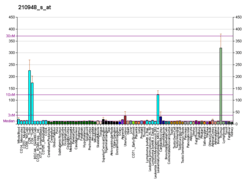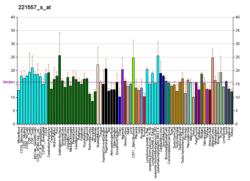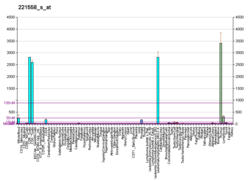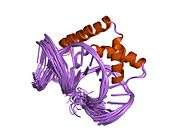Lymphoid enhancer-binding factor 1
Lymphoid enhancer-binding factor 1 (LEF1) is a protein that in humans is encoded by the LEF1 gene.[5]
Function
Lymphoid enhancer-binding factor-1 (LEF1) is a 48-kD nuclear protein that is expressed in pre-B and T cells. It binds to a functionally important site in the T-cell receptor-alpha (TCRA) enhancer and confers maximal enhancer activity. LEF1 belongs to a family of regulatory proteins that share homology with high mobility group protein-1 (HMG1).[6]
Clinical significance
LEF1 is highly overexpressed and associated with disease progression and poor prognosis in B-cell chronic lymphocytic leukemia.[7] It is also a promising potential drug target.[8]
Interactions
Lymphoid enhancer-binding factor 1 has been shown to interact with:
References
- 1 2 3 GRCh38: Ensembl release 89: ENSG00000138795 - Ensembl, May 2017
- 1 2 3 GRCm38: Ensembl release 89: ENSMUSG00000027985 - Ensembl, May 2017
- ↑ "Human PubMed Reference:".
- ↑ "Mouse PubMed Reference:".
- ↑ Milatovich A, Travis A, Grosschedl R, Francke U (Mar 1992). "Gene for lymphoid enhancer-binding factor 1 (LEF1) mapped to human chromosome 4 (q23-q25) and mouse chromosome 3 near Egf". Genomics. 11 (4): 1040–8. doi:10.1016/0888-7543(91)90030-I. PMID 1783375.
- ↑ "Entrez Gene: LEF1 lymphoid enhancer-binding factor 1".
- ↑ Erdfelder F, Hertweck M, Filipovich A, Uhrmacher S, Kreuzer KA (2010). "High lymphoid enhancer- binding factor-1 expression is associated with disease progression and poor prognosis in chronic lymphocytic leukemia". Hematology Reports. 2 (1): 3. doi:10.4081/hr.2010.e3.
- ↑ Gandhirajan RK, Staib PA, Minke K, Gehrke I, Plickert G, Schlösser A, Schmitt EK, Hallek M, Kreuzer KA (April 2010). "Small molecule inhibitors of Wnt/beta-catenin/lef-1 signaling induces apoptosis in chronic lymphocytic leukemia cells in vitro and in vivo". Neoplasia. 12 (4): 326–35. doi:10.1593/neo.91972. PMC 2847740. PMID 20360943.
- ↑ Boras K, Hamel PA (January 2002). "Alx4 binding to LEF-1 regulates N-CAM promoter activity". J. Biol. Chem. 277 (2): 1120–7. doi:10.1074/jbc.M109912200. PMID 11696550.
- ↑ Lutterbach B, Westendorf JJ, Linggi B, Isaac S, Seto E, Hiebert SW (January 2000). "A mechanism of repression by acute myeloid leukemia-1, the target of multiple chromosomal translocations in acute leukemia". J. Biol. Chem. 275 (1): 651–6. doi:10.1074/jbc.275.1.651. PMID 10617663.
- ↑ Edlund S, Lee SY, Grimsby S, Zhang S, Aspenström P, Heldin CH, Landström M (February 2005). "Interaction between Smad7 and beta-catenin: importance for transforming growth factor beta-induced apoptosis". Mol. Cell. Biol. 25 (4): 1475–88. doi:10.1128/MCB.25.4.1475-1488.2005. PMC 548008. PMID 15684397.
- ↑ Grueneberg DA, Pablo L, Hu KQ, August P, Weng Z, Papkoff J (June 2003). "A functional screen in human cells identifies UBF2 as an RNA polymerase II transcription factor that enhances the beta-catenin signaling pathway". Mol. Cell. Biol. 23 (11): 3936–50. doi:10.1128/MCB.23.11.3936-3950.2003. PMC 155208. PMID 12748295.
- ↑ Behrens J, von Kries JP, Kühl M, Bruhn L, Wedlich D, Grosschedl R, Birchmeier W (August 1996). "Functional interaction of beta-catenin with the transcription factor LEF-1". Nature. 382 (6592): 638–42. doi:10.1038/382638a0. PMID 8757136.
- 1 2 3 Labbé E, Letamendia A, Attisano L (July 2000). "Association of Smads with lymphoid enhancer binding factor 1/T cell-specific factor mediates cooperative signaling by the transforming growth factor-beta and wnt pathways". Proc. Natl. Acad. Sci. U.S.A. 97 (15): 8358–63. doi:10.1073/pnas.150152697. PMC 26952. PMID 10890911.
- ↑ Hecht A, Stemmler MP (February 2003). "Identification of a promoter-specific transcriptional activation domain at the C terminus of the Wnt effector protein T-cell factor 4". J. Biol. Chem. 278 (6): 3776–85. doi:10.1074/jbc.M210081200. PMID 12446687.
- ↑ Yasumoto K, Takeda K, Saito H, Watanabe K, Takahashi K, Shibahara S (June 2002). "Microphthalmia-associated transcription factor interacts with LEF-1, a mediator of Wnt signaling". EMBO J. 21 (11): 2703–14. doi:10.1093/emboj/21.11.2703. PMC 126018. PMID 12032083.
- ↑ Sachdev S, Bruhn L, Sieber H, Pichler A, Melchior F, Grosschedl R (December 2001). "PIASy, a nuclear matrix-associated SUMO E3 ligase, represses LEF1 activity by sequestration into nuclear bodies". Genes Dev. 15 (23): 3088–103. doi:10.1101/gad.944801. PMC 312834. PMID 11731474.
Further reading
- Waterman ML (2004). "Lymphoid enhancer factor/T cell factor expression in colorectal cancer". Cancer Metastasis Rev. 23 (1–2): 41–52. doi:10.1023/A:1025858928620. PMID 15000148.
- Skokowa J, Welte K (2007). "LEF-1 is a decisive transcription factor in neutrophil granulopoiesis". Ann. N. Y. Acad. Sci. 1106: 143–51. doi:10.1196/annals.1392.012. PMID 17360796.
- Travis A, Amsterdam A, Belanger C, Grosschedl R (1991). "LEF-1, a gene encoding a lymphoid-specific protein with an HMG domain, regulates T-cell receptor alpha enhancer function [corrected]". Genes Dev. 5 (5): 880–94. doi:10.1101/gad.5.5.880. PMID 1827423.
- van de Wetering M, Oosterwegel M, Dooijes D, Clevers H (1991). "Identification and cloning of TCF-1, a T lymphocyte-specific transcription factor containing a sequence-specific HMG box". EMBO J. 10 (1): 123–32. PMC 452620. PMID 1989880.
- Waterman ML, Fischer WH, Jones KA (1991). "A thymus-specific member of the HMG protein family regulates the human T cell receptor C alpha enhancer". Genes Dev. 5 (4): 656–69. doi:10.1101/gad.5.4.656. PMID 2010090.
- Zhou P, Byrne C, Jacobs J, Fuchs E (1995). "Lymphoid enhancer factor 1 directs hair follicle patterning and epithelial cell fate". Genes Dev. 9 (6): 700–13. doi:10.1101/gad.9.6.700. PMID 7537238.
- Maruyama K, Sugano S (1994). "Oligo-capping: a simple method to replace the cap structure of eukaryotic mRNAs with oligoribonucleotides". Gene. 138 (1–2): 171–4. doi:10.1016/0378-1119(94)90802-8. PMID 8125298.
- Prieve MG, Guttridge KL, Munguia JE, Waterman ML (1996). "The nuclear localization signal of lymphoid enhancer factor-1 is recognized by two differentially expressed Srp1-nuclear localization sequence receptor proteins". J. Biol. Chem. 271 (13): 7654–8. doi:10.1074/jbc.271.13.7654. PMID 8631802.
- Behrens J, von Kries JP, Kühl M, et al. (1996). "Functional interaction of beta-catenin with the transcription factor LEF-1". Nature. 382 (6592): 638–42. doi:10.1038/382638a0. PMID 8757136.
- Bagga R, Emerson BM (1997). "An HMG I/Y-containing repressor complex and supercoiled DNA topology are critical for long-range enhancer-dependent transcription in vitro". Genes Dev. 11 (5): 629–39. doi:10.1101/gad.11.5.629. PMID 9119227.
- Bruhn L, Munnerlyn A, Grosschedl R (1997). "ALY, a context-dependent coactivator of LEF-1 and AML-1, is required for TCRalpha enhancer function". Genes Dev. 11 (5): 640–53. doi:10.1101/gad.11.5.640. PMID 9119228.
- Brannon M, Gomperts M, Sumoy L, et al. (1997). "A beta-catenin/XTcf-3 complex binds to the siamois promoter to regulate dorsal axis specification in Xenopus". Genes Dev. 11 (18): 2359–70. doi:10.1101/gad.11.18.2359. PMC 316518. PMID 9308964.
- Suzuki Y, Yoshitomo-Nakagawa K, Maruyama K, et al. (1997). "Construction and characterization of a full length-enriched and a 5'-end-enriched cDNA library". Gene. 200 (1–2): 149–56. doi:10.1016/S0378-1119(97)00411-3. PMID 9373149.
- Korinek V, Barker N, Willert K, et al. (1998). "Two members of the Tcf family implicated in Wnt/beta-catenin signaling during embryogenesis in the mouse". Mol. Cell. Biol. 18 (3): 1248–56. PMC 108837. PMID 9488439.
- Prieve MG, Guttridge KL, Munguia J, Waterman ML (1998). "Differential importin-alpha recognition and nuclear transport by nuclear localization signals within the high-mobility-group DNA binding domains of lymphoid enhancer factor 1 and T-cell factor 1". Mol. Cell. Biol. 18 (8): 4819–32. PMC 109067. PMID 9671491.
- Levanon D, Goldstein RE, Bernstein Y, et al. (1998). "Transcriptional repression by AML1 and LEF-1 is mediated by the TLE/Groucho corepressors". Proc. Natl. Acad. Sci. U.S.A. 95 (20): 11590–5. doi:10.1073/pnas.95.20.11590. PMC 21685. PMID 9751710.
- Hovanes K, Li TW, Waterman ML (2000). "The human LEF-1 gene contains a promoter preferentially active in lymphocytes and encodes multiple isoforms derived from alternative splicing". Nucleic Acids Res. 28 (9): 1994–2003. doi:10.1093/nar/28.9.1994. PMC 103301. PMID 10756202.
- Labbé E, Letamendia A, Attisano L (2000). "Association of Smads with lymphoid enhancer binding factor 1/T cell-specific factor mediates cooperative signaling by the transforming growth factor-beta and wnt pathways". Proc. Natl. Acad. Sci. U.S.A. 97 (15): 8358–63. doi:10.1073/pnas.150152697. PMC 26952. PMID 10890911.
- Brantjes H, Roose J, van De Wetering M, Clevers H (2001). "All Tcf HMG box transcription factors interact with Groucho-related co-repressors". Nucleic Acids Res. 29 (7): 1410–9. doi:10.1093/nar/29.7.1410. PMC 31284. PMID 11266540.
External links
- LEF1+protein,+human at the US National Library of Medicine Medical Subject Headings (MeSH)
This article incorporates text from the United States National Library of Medicine, which is in the public domain.








